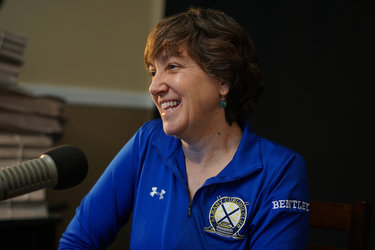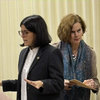For Kathy Bentley, curling is about making friends as much as winning
GUILDERLAND — Curling, says Kathy Bentley, is like playing chess on ice.
The ancient Scottish game is not just about technique and precision, but also about strategy.
Bentley ought to know. Two years ago, she was a United States Women’s Curling Association Senior champion along with teammates Marilyn Goldstein, Martha Naber, and Wendy Berger. The four women had been curling together for 15 years.
They competed on their home ice, which longtime Albany Curling Club member Melvin Abelseth has called the best-kept secret in Guilderland.
Their clubhouse, with two ice sheets and a “warm room” — where spectators can relax and watch the competition — is located on McKown Road.
The club was founded in 1955 with 16 members and now has about 150.
There are four players on each team — eight players in a game — and their goal is to slide 43-pound granite rocks as close as they can to the center of a series of rings, which looks rather like a bull’s eye, 140 feet away.
Once a little-known sport, curling’s popularity increased after it became an Olympic sport in 1998.
Bentley was drawn to the sport when she went to an open house at the McKown Road facility. “Myself and my son just absolutely fell in love with it,” Bentley says in this week’s Enterprise podcast.
Her son became a competitive junior curler. At 25 now, he lives in Dallas and has given up the sport, but Bentley is still at it.
One of the things she loves about the game is the camaraderie it inspires. Her club frequently holds weekend-long bonspiels — from the Dutch for good games. The curlers visit other clubs for bonspiels and connect with their competitors.
“After the game, the two teams, eight people total, will sit together and socialize,” says Bentley. “The winner buys the loser a drink.”
It’s a great way to meet people, Bentley says, and she has made lifelong friends through the sport.
She appreciates that they are different ages and come from all walks of life. The Albany Curling Club currently has members ranging in age from 10 to 90.
Bentley has traveled to clubs all around the country — most recently in Denver — to compete, and she particularly relished a competition at a historic clubhouse in Montreal. Some of the best curlers come from Canada, she said.
Women have long participated in the sport. When Bentley joined the Albany Curling Club over 15 years ago — she is now its president — about 30 percent of its members were women. “Now we’re almost 50-50 with women and men in the club,” she said.
There are leagues for women, leagues for men, and mixed leagues. Even if you are brand new to the sport, said Bentley, you can be put on a team with players who have been curling for five years, 10 years, or 20 years.
“Some of our older curlers, if they’ve been curling for 50 years, they know exactly where that rock is going to stop,” said Bentley.
Each four-member team has one member called “the skip.” Bentley explained, “They’re kind of like the captain … the one who calls the shots. The other people, when they’re not delivering a rock, throwing a rock, they’re busy sweeping.”
Sweeping isn’t done, as in the old days, with brooms that could leave straw on the rough outdoor ice. Rather, special “brooms” are used, each with a light carbon fiber handle affixed to a nylon pad, Bentley explained.
By sweeping the ice, a player is “meling just a little microscopically thin layer of ice and that makes the rock go a little further,” she said. “You can’t really change the path of the rock too much but, by effectively sweeping, then you can finetune where that rock is going to end up.”
Sweeping, she added, is great exercise.
The only other equipment used by curlers are special shoes. Skates aren’t worn as they would damage the ice.
One shoe has a Teflon-like coating of hard plastic on its sole. “That is very slippery on the ice and that’s actually what you slide out on as you deliver the rock,” said Bentley.
The other shoe has a sole that anchors the player.
“The goal,” said Bentley, “is that we would all deliver a rock in the same way, and we’d all look just like Olympians. That honestly doesn’t really happen. They make it look so easy.”
The game’s strategy comes into play in how the rock is delivered — quickly to take out an opponent’s rock or placed as a guard in front of a teammate’s rock.
The ice will change as the game is being played. “Quite often,” said Bentley, “the ice starts out being a little slow so you have to push the rock a little harder. But then, as paths get worn in the ice, as people are sweeping it … that particular path might get a little faster.”
The game gets its name from the path the rocks take. “You rotate the stone very slightly clockwise or counterclockwise so that makes it curl,” said Bentley. “It slowly starts out going straight but then, as it slows down, it’ll curl off to the right or curl off to the left, depending on how you roll.”
The Albany Curling Club’s goal, Bentley said, is to “promote the sport of curling, to educate people, to show more people what curling is like and what a great sport it is.”
The six-month season runs from October through the end of March although some clubs play year-round, she said.
Sometimes, in upstate New York, winters can “seem a little long,” said Bentley. But, with curling she said, she looks forward to the season. “Every winter,” Bentley said, “gives me a lot of socialization activity.”



